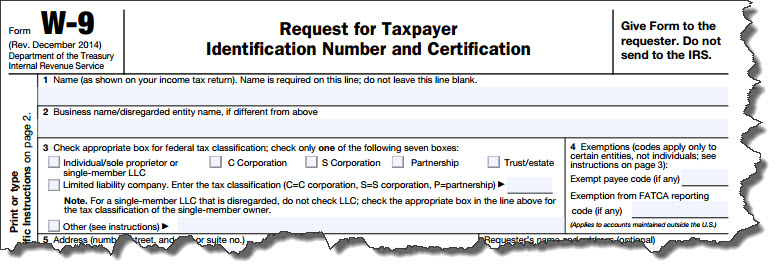You’re someone else’s boss now, and that means a whole bunch of paperwork – and new tax-related responsibilities.
If you’ve been working on your own up until now, you’ve probably got the whole self-employment tax thing down. You’re used to making your quarterly payments, and you understand the importance of saving receipts, tracking purchases that can be considered business expenses, and filing early so you can see how close your estimated payments came to fulfilling your tax obligation during the year.
You’ve done well enough that you’re finally able to hire some help, whether it’s a full-time employee or an independent contractor. If it’s the latter, your tax-related responsibilities are few. You’ll have to ask your new worker to first complete a Form W-9, supplying his or her name and address, tax classification, and Social Security Number or Employer Identification Number.

Before you start paying an independent contractor, they’ll have to fill in a Form W-9.
Though there are some exceptions, you’ll most likely have to supply a FORM 1099-MISC to both the contractor and the IRS if you’ve paid the individual $600 or more during the year.
If you’re hiring a full-time employee, though, you’ll be dealing with additional paperwork.
Note: It’s very important that you distinguish between these two types of workers and comply with the IRS’ requirements for each correctly.
Between the time that you hire someone as an employee and the time he or she starts work, you need to have a good understanding of your responsibilities, including:
Withholding federal income tax from wages. Using current payroll tax tables, you must determine how much income tax you need to withhold from each paycheck. The IRS requires that these payments be deposited, but the requirements for deposits vary depending on the type of business you operate and the amounts withheld.
- Withholding Social Security and Medicare taxes. You’re responsible for withholding – and depositing — part of these taxes from the employee’s wages. Your company will have to pay a matching amount.
- Withholding Additional Medicare Tax. This requirement took effect January 1, 2013. Employees whose compensation exceeds a specified threshold amount must pay an additional 0.9 percent.
- Supplying the new employee with a Form W-4. If you’ve ever been an employee yourself, you’ll recall filling out this document, which helps the employer withhold the correct amount of income tax based on the number of allowances claimed.
- Supplying the employee with a Form W-2 (Wage and Tax Statement). This document, which is prepared after the final payroll of the year, reports wages, tips, and other compensation that the employee received.
- Asking the employee to complete a Form I-9. This verifies that the employee is eligible to work in the United States.
And there’s more. You’ll be filing new tax forms yourself and having to comply with payroll tax schedules, and possibly meeting state tax obligations.
Obviously, onboarding your first employee is a huge undertaking. If your continued success necessitates the hiring of more, you’ll know the drill by then. We’ll be happy to guide you through this initial process, to ensure that you’re completely compliant. Then you’ll be able to concentrate on integrating your new hire into your growing operation.
 Withholding federal income tax from wages. Using current payroll tax tables, you must determine how much income tax you need to withhold from each paycheck. The IRS requires that these payments be deposited, but the requirements for deposits vary depending on the type of business you operate and the amounts withheld.
Withholding federal income tax from wages. Using current payroll tax tables, you must determine how much income tax you need to withhold from each paycheck. The IRS requires that these payments be deposited, but the requirements for deposits vary depending on the type of business you operate and the amounts withheld.